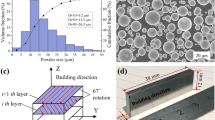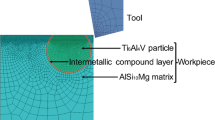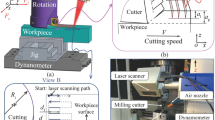Abstract
Selective laser melting (SLM) is an increasingly concerned trend in Ti-6Al-4V blade manufacturing, while the SLMed Ti-6Al-4V blade cannot be used directly because of poor surface integrity and high residual stresses. Precise machining after SLM is a feasible solution but also a challenge. The low rigidity of the blade will lead to deformation when machining. The deformation can lead to surface error and may make defect parts. Two-step machining processes to address the problems were proposed in this paper. First, a non-uniform allowances distribution was allocated and optimized in semi-finishing based on Ritz solution to elastic deformation. The blade was simplified as a cantilever thin plate with various thicknesses, and the thicknesses of finishing allowances were designed and optimized on the premise of ensuring the thin-wall stiffness of the blade, so as to realize the design of Ritz non-uniform allowances. Then, finishing machining was conducted to achieve precise parts. A blade deformation model was established to evaluate part distortions with cutting force moving and changing. Finite element analysis (FEA) and experimental validation in ball-end milling of a blade were conducted. FEA results and experimental results showed dimensional errors have been reduced up to 50%. Further surface tests demonstrated that the mean surface roughness reduced from 7.88 to 0.815 μm. And the residual surface stresses of the SLM samples changed after semi-finishing machining due to the residual stresses relaxation and redistribution. The results demonstrated that the proposed method enhanced the surface quality of the blade fabricated by SLM.















Similar content being viewed by others
Availability of data and material
Not applicable.
Code availability
Not applicable.
References
Jiménez A, Bidare P, Hassanin H, Tarlochan F, Dimov S, Essa K (2021) Powder-based laser hybrid additive manufacturing of metals: a review. Int J Adv Manuf Technol 114:63–96. https://doi.org/10.1007/s00170-021-06855-4
Gurrappa I (2003) Characterization of titanium alloy Ti-6Al-4V for chemical, marine and industrial applications. Mater Charact 51:131–139. https://doi.org/10.1016/j.matchar.2003.10.006
Li Z, Tuysuz O, Zhu L, Altintas Y (2018) Surface form error prediction in five-axis flank milling of thin-walled parts. Int J Mach Tools Manuf 128:21–32. https://doi.org/10.1016/j.ijmachtools.2018.01.005
Huang N, Bi Q, Wang Y, Sun C (2014) 5-axis adaptive flank milling of flexible thin-walled parts based on the on-machine measurement. Int J Mach Tools Manuf 84:1–8. https://doi.org/10.1016/j.ijmachtools.2014.04.004
Gao Y, Ma J, Jia Z, Wang F, Si L, Song D (2016) Tool path planning and machining deformation compensation in high-speed milling for difficult-to-machine material thin-walled parts with curved surface. Int J Adv Manuf Technol 84:1757–1767. https://doi.org/10.1007/s00170-015-7825-4
Li Z, Zhu L (2019) Compensation of deformation errors in five-axis flank milling of thin-walled parts via tool path optimization. Precis Eng 55:77–87. https://doi.org/10.1016/j.precisioneng.2018.08.010
Song Q, Shi J, Liu Z, Wan Y (2016) Dynamic analysis of rectangular thin plates of arbitrary boundary conditions under moving loads. Int J Mech Sci 117:16–29. https://doi.org/10.1016/j.ijmecsci.2016.08.005
Shi J, Gao J, Song Q, Liu Z, Wan Y (2017) Dynamic deformation of thin-walled plate with variable thickness under moving milling force. Procedia CIRP 58:311–316. https://doi.org/10.1016/j.procir.2017.03.329
Wu K, He N, Liao WH, Zhao W (2004) Study on machining deformations and their control approaches of the thin-web in end milling. China Mechanical Engineering 15(8):670–674
Chen W, Lou P, Chen H (2009) Active compensation methods of machining deformation of thin-walled parts. Hangkong Xuebao/Acta Aeronautica et Astronautica Sinica 30:570–576
Chen YZ, Chen WF, Liang RJ, Feng T (2017) Machining allowance optimal distribution of thin-walled structure based on deformation control. Appl Mech Mater 868:158–165. https://doi.org/10.4028/www.scientific.net/AMM.868.158
Tian W, Ren J, Wang D, Zhang B (2018) Optimization of non-uniform allowance process of thin-walled parts based on eigenvalue sensitivity. Int J Adv Manuf Technol 96:2101–2116. https://doi.org/10.1007/s00170-018-1740-4
Shan C, Zhao Y, Liu W, Zhang D (2013) A nonuniform offset surface rigidity compensation strategy in numerical controlled machining of thin-walled cantilever blades. Hangkong Xuebao/Acta Aeronautica et Astronautica Sinica 34:686–693
Rahman M, Heikkala J, Lappalainen K (2000) Modeling, measurement and error compensation of multi-axis machine tools. Part I: theory. Int J Mach Tools Manuf 40:1535–1546. https://doi.org/10.1016/S0890-6955(99)00101-7
Ratchev S, Liu S, Huang W, Becker AA (2006) An advanced FEA based force induced error compensation strategy in milling. Int J Mach Tools Manuf 46:542–551. https://doi.org/10.1016/j.ijmachtools.2005.06.003
Guo H, Zuo DW, Wu HB, Xu F, Tong GQ (2009) Prediction on milling distortion for aero-multi-frame parts. Mater Sci Eng, A 499:230–233. https://doi.org/10.1016/j.msea.2007.11.137
Zhang J, Lin B, Fei J, Huang T, Xiao J, Zhang X, Ji C (2018) Modeling and experimental validation for surface error caused by axial cutting force in end-milling process. Int J Adv Manuf Technol 99:327–335. https://doi.org/10.1007/s00170-018-2468-x
Khandagale P, Bhakar G, Kartik V, Joshi SS (2018) Modelling time-domain vibratory deflection response of thin-walled cantilever workpieces during flank milling. J Manuf Process 33:278–290. https://doi.org/10.1016/j.jmapro.2018.05.011
Zozulya VV, Cartmell S, Basak TK (2011) Numerical solution of the Kirchhoff plate bending problem with BEM. ISRN Mechanical Engineering 2011:295904. https://doi.org/10.5402/2011/295904
Ritz W (1909) Theorie der Transversalschwingungen einer quadratischen Platte mit freien Rändern. Ann Phys 333:737–786. https://doi.org/10.1002/andp.19093330403
Sadílek M, Poruba Z, Čepová L, Šajgalík M (2020) Increasing the accuracy of free-form surface multiaxis milling. Materials 14:25. https://doi.org/10.3390/ma14010025
Mirkoohi E, Bocchini P, Liang SY (2019) Inverse analysis of residual stress in orthogonal cutting. J Manuf Process 38:462–471. https://doi.org/10.1016/j.jmapro.2019.01.033
Huang X, Zhang X, Han D (2015) An analytical model of residual stress for flank milling of Ti-6Al-4V. Procedia CIRP 31:287–292. https://doi.org/10.1016/j.procir.2015.03.061
Yao C, Zhang J, Cui MC, Tan L, Shen XH (2020) Machining deformation prediction of large fan blades based on loading uneven residual stress. Int J Adv Manuf Technol 107:4345–4356. https://doi.org/10.1007/s00170-020-05316-8
Funding
This work was financially supported by the National Natural Science Foundation of China (Nos. 51775280 and 51675285).
Author information
Authors and Affiliations
Corresponding authors
Ethics declarations
Ethics approval
Not applicable.
Consent to participate
Not applicable.
Consent for publication
The authors gave consent for publication.
Competing interests
The authors declare no competing interests.
Additional information
Publisher's Note
Springer Nature remains neutral with regard to jurisdictional claims in published maps and institutional affiliations.
Rights and permissions
About this article
Cite this article
Zhang, B., Yuan, J., Wang, Z. et al. Precise machining based on Ritz non-uniform allowances for titanium blade fabricated by selective laser melting. Int J Adv Manuf Technol 119, 6029–6044 (2022). https://doi.org/10.1007/s00170-022-08701-7
Received:
Accepted:
Published:
Issue Date:
DOI: https://doi.org/10.1007/s00170-022-08701-7




